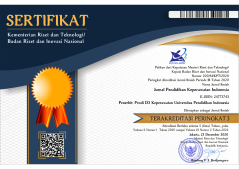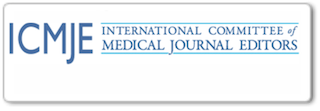Spiritual Well-Being Of Post-Stroke Patients In Neurological Polyclinic of Al Ihsan Regional Public Hospital, West Java Province
Abstract
ABSTRAK
Stroke fase rehabilitasi dapat mengakibatkan perubahan fisik dan psikologis sehingga mempengaruhi kualitas hidup pasien yang kemudian menyebabkan masalah psikosial berupa cemas dan depresi. Cemas dan depresi ini memiliki korelasi terhadap kesejahteraan spiritual. Tujuan dari penelitian ini adalah untuk mengidentifikasi tingkat kesejahteraan spiritual pada pasien pasca stroke di poliklinik RSUD Al Ihsan Provinsi Jawa Barat. Penelitian ini merupakan penelitian deskriptif kuantitatif dengan menggunakan instrumen SIWB. Penarikan sampel menggunakan metode purposive sampling dengan kriteria insklusi pasien stroke fase rehabilitasi yang mempunyai nilai Mini Mental State Examination (MMSE) normal 24-30, dan didapatkan 105 responden. Data disajikan dalam bentuk distribusi frekuensi. Hasil penelitian ini menunjukkan tingkat kesejahteraan spiritual tinggi sebanyak 57 responden (54,3%) dan tingkat kesejahteraan spiritual rendah sebanyak 48 responden (45,7%). Karakteristik responden paling banyak pada rentang usia lansia akhir yaitu berjumlah 41 responden (39,0%), dengan lama stroke > 12 bulan 58 responden (55,2%), memiliki penyakit penyerta 82 responden (78,1%), dan mengalami serangan stroke 1x sebanyak 54 responden (51,4%). Pada penelitian ini, antara tingkat kesejahteraan spiritual tinggi dan rendah tidak jauh berbeda persentasenya. Sehingga masih diperlukan upaya untuk meningkatakan kesejahteraan spiritual melalui perbaikan sarana dan prasaran ibadah ,mengoptimalkan spiritual care, mengadakan seminar-seminar dan pelatihan spiritual care, melakukan berdo’a bersama sebelum pemeriksaan dimulai, menciptakan lingkungan yang nyaman, aman, dan damai, serta mengadakan peer group khusus pasien stroke.
ABSRTACT
Stroke rehabilitation phase can lead to physical and psychological changes. It has an impact on the quality of life of patients that later caused psychosocial problems such as anxiety and depression. These anxiety and depression have a correlation to the spiritual well-being. The purpose of this study was to identify the level of spiritual well-being in post-stroke patients in polyclinic RSUD Al Ihsan West Java Province. This research was a quantitative descriptive research using SIWB instruments. It used a purposive sampling method with the inclusion criteria of rehabilitation phase stroke patients who had 24-30 as the normal score of Million Minimum State Examination (MMSE) and obtained 105 respondents. The data presented in the form of the frequency distribution. The results of this study indicated that the respondent’s amount who reached the high level of spiritual well-being was 57 respondents (54.3%) and low level of spiritual well-being was 48 respondents (45.7%). The most respondents’ characteristic were respondents with age range of elderly as of 41 respondents (39.0%), with stroke length more than 12 months as of 58 respondents (55.2%), had comorbid disease as of 82 respondents (78.1%), and suffered once stroke attack as of 54 respondents (51.4%). The research revealed that the percentage level of spiritual well-being between high and low was nearly similar. As the consequences, it is necessary to increase the spiritual well-being through the improvement of religious facilities and infrastructure, optimizing spiritual care, conducting seminars and spiritual care training, praying together before the medical check-up or treatment, creating a comfortable, safe and peaceful environment, and establish the peer group for stroke patients.
Keywords
Full Text:
PDFReferences
A’la, M. Z., Efendi, D., & Komarudin, K. (2015). Kesejahteraan Spiritual Keluarga Pasien Stroke dan Kaitannya dengan Depresi. Jurnal Ners Dan Kebidanan Indonesia, 3(3), 129–133. https://doi.org/10.21927/jnki.2015.3(3).129-133
Adegbola M. (2006). Spirituality and Quality of Life in Chronic Illness. J Theory Construction & Testing.
Anandarajah, G., & Hight, E. (2001). Spirituality and medical Practise : using the HOPE questions as a practical tool for spiritual assasement. American Family Physician.
Ariani. (2015). Hubungan Spiritualitas Perawat dan Kompetensi Asuhan Spiritual, 10 No 2, 130–140.
Ariyani, H., Suryani., Nuraeni A. (2014). Perbedaan Persepsi Perawat dan Pasien Terhadap kebutuhan spiritual Pasien sindrom Koroner Akut. Thesis. Universitas Padjadjaran.
Bandura A. (1997). Self-Efficacy: The Excercise of Control. New York: W.H. Freeman and Company.
Batticaca, F. (2008). Asuhan Keperawatan Klien dgn Gangguan Persarafan. Penerbit Salemba. Retrieved from https://books.google.co.id/books?id=AKDNoVXFVnEC
Blackwell, W. (2015). NURSING DIAGNOSIS. Definitions and Classification 2015-2017 (Ed 10). Penerbit : EGC.
Boland, C. S. (2000). Social Support and Spiritual well-being: Empowering older Adults to Commit to Health Promoting Behaviors (p. 6: 12-23). Journal of Multicultural Nursing and Health.
Brown I., Renwick, R., Nagler, M. (1996). Conceptual Approaches, Issues, and Aplications. Quality of Life in Health Promotion and Rehabilitation. London: Sage Publication.
Bruce B. Frey, Timothy P. Daaleman, & Vicky Peyton. (2005). Measuring a Dimension of Spirituality for Health Research: Validity of the Spirituality Index of Well-Being. Research on Aging, Vol. 27 No, 556–577. https://doi.org/10.1177/ 0164027505277847
Burkhardt, M. A., & Nagai-Jacobson, M. G. (2005). Spirituality and Health. In Holistic Nursing a Handbook For Practise. Massachusetts: Jones and Bartlett Publisher.
Carod AFJ, Egido, J., Gonzales, J., & Seijas, E. De. (2009). Quality of life among stroke survivors evaluated 1 year after stroke. Experience of Stroke Unit, (Stroke), 31: 29950-3000.
Da browska-Bender, M., Milewska, M., Gobek, A., Duda-Zalewska, A., & Staniszewska, A. (2017). The Impact of Ischemic Cerebral Stroke on the Quality of Life of Patients Based on Clinical, Social, and Psychoemotional Factors. Journal of Stroke and Cerebrovascular Diseases. https://doi.org/10.1016/ j.jstrokecerebrovasdis.2016.08.036
Daaleman, T. P., & Frey, B. B. (2004). Spirituality index of well being: A new instrument for health-related quality of life research. Annals of Family Medicine, 2, 499–503. https://doi.org/10.1037/ t06487-
Ellison, C.W. (1983). Spiritual well being : conceptualization and measurement. Journal of Psychology and Theology, 11 (4), 330–340.
Frey, B., B., Daaleman, T. P., & Peyton, V. (2005). Measuring a dimension of spirituality for health research : Validity of the spirituality index of well-being. Research on Aging, 27(5), 556-557. https://doi.org/10.1177/0164027505277847
Graham, Furr, Flower, & Burke. (2001). Research and Theory Religion and Spirituality in Coping With Stress. Journal of Advanced Nursing.
Harold G. Koenig. (2012). Review Article Religion, Spirituality, and Health: The Research and Clinical Implication. International Scholarly Research Network. https://doi.org/10.5402/2012/ 278730
Hawari, D. (2004). Doa dan Dzikir Sebagai Pelengkap. Jakarta: Dana Bhakti PrimaYasa.
Kociszewski. (2004). Spiritual care: A phenomenologic study of critical care nurses.Heart Lung.
Kozier, B., Erb, G., Berman, A., & Snyder, S. (2012). Kozier and Erb’s Fundamentals of Nursing: Concepts, Process and Practice. Nurse Education in Practice, 12(2), e12. https://doi.org/10.1016/ j.nepr.2011.09.002
Kurniawati, H. (2015). Studi Meta Analisis Spiritual Well Being dan Quality Of Life. SEMINAR PSIKOLOGI DAN KEMANUASIAAN.
Lewis, M.B., & Eric, J.P. (2013). Spirituality as Coping Mechanism for Chronic Illness. Clinical Scholars Review.
Ni Putu Sriyanti, Warjiman, Mohammad Basit. (2016). Hubungan Kesejahteraan Spiritual Dengan Kualitas Hidup Pasien Pasca Stroke.
Nouguchi W. , Morita S., Ohno T., Aihara O., Tsujii H., S. K. et al; (2006). Spiritual Needs in Cancer Patient and Spiritual Care Based on Logotherapy. Supportive Care Cancer.
Nuraeni, A., Nurhidayah, I., Mambang Sari, C. W.,& Mirwanti, R. (2016). Kebutuhan Spiritual pad Pasien Kanker. Fakultas Keperawatan Universitas Padjadjaran. Retrieved from http://www.researchgate. net/publication/291349036
Nuraeni, A., & Mirwanti, R. (2016). Hubungan Kesejahteraan Spiritual Dengan Depresi Pada Pasien Dengan Penyakit Jantung Koroner. Medisains. Jurnal Ilmiah Ilmu-Ilmu Kesehatan, 14(1), 46–52. Retrieved from https://ejournal.unsrat.ac.id/index.php/egigi/article/view/14222/13796
Piaget, Jean. (2002). Tingkat Perkembangan Kognitif. Jakarta: Gramedia.
Potter, P. A., & Perry, A. G. (2005). Buku ajar fundamental keperawatan: konsep, proses, dan praktik. Jakarta: EGC, 1376. https://doi.org/IOS3107-49534
Potter, P. A., & Perry, A. G. (2009). Fundamental Keperawatan Buku I (Ed. 7). Jakarta: Salemba Medika.
Rodrigues, R. A., Marques, S., Kusumota, L., dos Santos, E. B., Fhon, J. R.,
& Fabricio-Wehbe, S. C. (2013). Transition of care for the elderly after cerebrovascular accidents--from hospital to the home. Revista Latino-Americana de Enfermagem, 21 Spec No, 216–224. https://doi.org/http://dx.doi.org/10.1590/S0104-11692013000700027
Ruggeri M., Bisoffi G. & Fontecedro L. (2001). Subjective and objective dimensions of quality of life in psychiatric patients: a factor analytical approach. The British Journal of Psychiatri, 178, 268–275.
Widarti, L. et al. (2012). RESPONS PSIKOLOGIS (KECEMASAN DAN DEPRESI) DAN RESPONS BIOLOGIS (CORTISOL, IFN- γ DAN TNF- α ) PADA PASIEN STROKE ISKEMIK DENGAN PENDEKATAN MODEL.
Yayasan Stroke Indonesia. (2012). Tahun 2020, Penderita Stroke Meningkat 2 Kali. Yayasan Stroke Indonesia.
DOI: https://doi.org/10.17509/jpki.v4i1.12341
Refbacks
- There are currently no refbacks.
Jurnal Pendidikan Keperawatan Indonesia(JPKI) published by Indonesia University of Education. JPKI is licensed under a Creative Commons Attribution-ShareAlike 4.0 International License.
Office :
Nursing Department. FPOK UPI.
229, Dr. Setiabudhi Street. Bandung 40154
West Java , Indonesia
E-mail : jpki@upi.edu

_.png)
_.png)
_.png)











